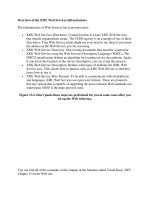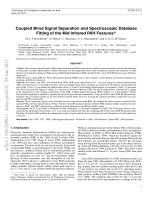Manning Early Access Program Secrets of the JavaScript Ninja version 10 ppt
Bạn đang xem bản rút gọn của tài liệu. Xem và tải ngay bản đầy đủ của tài liệu tại đây (8.84 MB, 364 trang )
©Manning Publications Co. Please post comments or corrections to the Author Online forum:
/>
MEAP Edition
Manning Early Access Program
Secrets of the JavaScript Ninja version 10
Copyright 2012 Manning Publications
For more information on this and other Manning titles go to
www.manning.com
Licensed to <>
©Manning Publications Co. Please post comments or corrections to the Author Online forum:
/>
brief contents
1. Enter the ninja
2. Testing and debugging
3. Functions are fundamental
4. Wielding functions
5. Closing in on closures
6. Object-orientation with prototypes
7. Wrangling regular expressions
8. Taming threads and timers
9. Ninja alchemy: Run-time code evaluation
10. With statements
11. Developing cross-browser strategies
12. Cutting through attributes, properties, and CSS
13. Surviving events
14. Manipulating the DOM
15. CSS selector engine
Licensed to <>
©Manning Publications Co. Please post comments or corrections to the Author Online forum:
/>
1
Enter the ninja
In this chapter:
A look at the purpose and structure of this book
Which libraries we will focus upon
What is advanced JavaScript programming?
Cross-browser authoring
Test suite examples
If you are reading this book, you know that there is nothing simple about creating effective
and cross-browser JavaScript code. In addition to the normal challenges of writing clean
code, we have the added complexity of dealing with obtuse browser differences and
complexities. To deal with these challenges, JavaScript developers frequently capture sets of
common and reusable functionality in the form of JavaScript libraries. These libraries vary
widely in approach, content and complexity, but one constant remains: they need to be easy
to use, incur the least amount of overhead, and be able to work across all browsers that we
wish to target.
It stands to reason then, that understanding how the very best JavaScript libraries are
constructed can provide us with great insight into how your own code can be constructed to
achieve these same goals. This book sets out to uncover the techniques and secrets used by
these world-class code bases, and to gather them into a single resource.
In this book we'll be examining the techniques that are used to create two of the more
popular JavaScript libraries. Let’s meet them!
1.1 Our key JavaScript libraries
The techniques and practices used to create two modern JavaScript libraries will be the focus
of our particular attention in this book. They are:
1
Licensed to <>
©Manning Publications Co. Please post comments or corrections to the Author Online forum:
/>
Prototype ( the godfather of the modern JavaScript libraries
created by Sam Stephenson and released in 2005. This library embodies DOM, Ajax,
and event functionality, in addition to object-oriented, aspect-oriented, and functional
programming techniques.
jQuery (
) , created by John Resig and released in January of 2006.
jQuery popularized the use of CSS selectors to match DOM content. Includes DOM,
Ajax, event, and animation functionality.
These two libraries currently dominate the JavaScript library market, being used on
hundreds of thousands of web sites, and interacted with by millions of users. Through
considerable use and feedback these libraries been refined over the years into the optimal
code bases that they are today. In addition to detailed examination of Prototype and jQuery,
we'll also look at a few of the techniques utilized by the following libraries:
Yahoo! UI (
the result of internal JavaScript
framework development at Yahoo! and released to the public in February of 2006.
Yahoo! UI includes DOM, Ajax, event, and animation capabilities in addition to a
number of pre-constructed widgets (calendar, grid, accordion, etc.).
base2 (
created by Dean Edwards and released
March 2007. This library supports DOM and event functionality. Its claim-to-fame is
that it attempts to implement the various W3C specifications in a universal, cross-
browser manner.
All of these libraries are well constructed and tackle their target problem areas
comprehensively. For these reasons they'll serve as a good basis for further analysis, and
understanding the fundamental construction of these code bases gives us insight into the
process of world-class JavaScript library construction.
But these techniques won't only be useful for constructing large libraries, but can be
applied to all JavaScript coding, regardless of size.
The make up of a JavaScript library can be broken down into three aspects: advanced use
of the JavaScript language, meticulous construction of cross-browser code, and a series of
best practices that tie everything together. We'll be carefully analyzing these three aspects
to give us a complete knowledge base with which we can create our own effective JavaScript
code.
1.2 Understanding the JavaScript Language
Many JavaScript coders, as they advance through their careers, may get to the point at
which they're actively using the vast array of elements comprising the language: including
objects and functions, and, if they've been paying attention to coding trends, even
anonymous inline functions, throughout their code. In many cases, however, those skills may
not be taken beyond fundamental skill levels. Additionally there is generally a very poor
understanding of the purpose and implementation of closures in JavaScript, which
fundamentally and irrevocably binds the importance of functions to the language.
2
Licensed to <>
©Manning Publications Co. Please post comments or corrections to the Author Online forum:
/>
JavaScript consists of a close relationship between objects, functions – which in
JavaScript are first class elements – and closures. Understanding the strong relationship
between these three concepts vastly improves our JavaScript programming ability, giving us
a strong foundation for any type of application development.
Figure 1.1 JavaScript consists of a close relationship between objects, functions and closures
Many JavaScript developers, especially those coming from an object-oriented
background, may pay a lot of attention to objects, but at the expense of understanding how
functions and closures contribute to the big picture.
In addition to these fundamental concepts, there are two features in JavaScript that are
woefully underused: timers and regular expressions. These two concepts have applications in
virtually any JavaScript code base, but aren't always used to their full potential due to their
misunderstood nature.
A firm grasp of how timers operate within the browser, all too frequently a mystery, gives
us the ability to tackle complex coding tasks such as long-running computations and smooth
animations. And an advanced of how regular expressions work allows us to simplify what
would otherwise be quite complicated pieces of code.
As another high point of our advanced tour of the JavaScript language, we'll take a look
at the
with statement later on in chapter 10, and the crucially important eval() method in
chapter 9.
All too often these two important language features are trivialized, misused, and even
condemned outright by many JavaScript programmers. But by looking at the work of some
of the best JavaScript coders we can see that, when used appropriately, these useful
features allow for the creation of some fantastic pieces of code that wouldn't be otherwise
3
Licensed to <>
©Manning Publications Co. Please post comments or corrections to the Author Online forum:
/>
possible. To a large degree they can also be used for some interesting meta-programming
exercises, molding JavaScript into whatever we want it to be.
Learning how to use these features responsibly and to their best advantage can certainly
elevate your code to higher levels.
Honing our skills to tie these concepts and features together gives us a level of
understanding that puts the creation of any type of JavaScript application within our reach,
and gives us a solid base for moving forward starting with writing solid, cross-browser code.
1.3 Cross-browser considerations
Perfecting our JavaScript programming skills will get us far, but when developing browser-
based JavaScript applications sooner, rather than later, we’re going to run face first into The
Browsers and their maddening issues and inconsistencies.
In a perfect world, all browsers would be bug-free and support Web Standards in a
consistent fashion, but we all know that we most certainly do not live in that world.
The quality of browsers has improved greatly as of late, but it's a given that they all still
have some bugs, missing APIs, and specific quirks that we’ll need to deal with. Developing a
comprehensive strategy for tackling these browser issues, and becoming intimately familiar
with their differences and quirks, is just as important, if not more so, than proficiency in
JavaScript itself.
When writing browser applications, or JavaScript libraries to be used in them, picking and
choosing which browsers to support is an important consideration. We’d like to support them
all, but development and testing resources dictates otherwise. So how do we decide which to
support, and to what level?
Throughout this book, an approach that we will employ is one that we’ll borrow from
Yahoo! that they call Graded Browser Support.
This technique, in which the level of browser support is graded as one of A, C, or X, is
described at
and defines the three level of
support as:
A: Modern browsers that take advantage of the power capabilities of web standards.
These browsers get full support with advanced functionality and visuals.
C: Older browsers that are either outdated or hardly used. These browsers receive
minimal support; usually limited to HTML and CSS with no scripting, and bare-bones
visuals.
X: Unknown or fringe browsers. Somewhat counter-intuitively, rather than being
unsupported, these browsers are given the benefit of the doubt, and assumed to be as
capable as A-grade browsers. Once the level of capability can be concretely
ascertained, these browsers can be assigned to A or C grade.
As of early 2011, the Yahoo! Graded Browser Support matrix was as shown in Table 1.1.
Any ungraded browser/platform combination, or unlisted browser, is assigned a grade of X.
4
Licensed to <>
©Manning Publications Co. Please post comments or corrections to the Author Online forum:
/>
Table 1.1 This early 2011 Graded Browser Support matrix shows the level of browser support
from Yahoo!
Windows
XP
Windows 7 Mac OS
10.6
iOS 3 iOS 4 Android 2.2
IE <6
C
IE 6, 7, 8
A
Firefox <3
C
Firefox 3
A
A
A
Firefox 4
A
A
Safari < 5
C
Safari 5+
A
Safari for
iOS
A A
Chrome
A
WebKit for
Android
A
Opera <9.5
C
Netscape <8
C
Note that this is the support chart as defined by Yahoo! for YUI 2 and YUI 3 – it is not a
recommendation on what we, in this book, or you, in your own projects, should support. But
by using this approach to come up with our own support matrix, we can determine the
balance between coverage and pragmatism to come up with the optimal set of browsers and
platforms that we should support.
It’s impractical to develop against a large number of platform/browser combinations, so
we must weigh the cost versus benefit of supporting the various browsers, and create our
own resulting support matrix.
This analysis must take in account multiple considerations, the primary of which are:
The market share of the browser
The amount of effort necessary to support the browser
Figure 1.2 shows a sample chart that represents your authors’ personal choices when
developing for some browsers (not all browsers included for brevity) based upon March 2011
market share:
5
Licensed to <>
©Manning Publications Co. Please post comments or corrections to the Author Online forum:
/>
Figure 1.2 Analyzing the cost versus benefit of supporting various browsers tells us where to put our effort
Charting the benefit versus cost in this manner shows us at a glance where we should put
our effort to get the most “bang for the buck”. Things that jump out of this chart:
6
Licensed to <>
©Manning Publications Co. Please post comments or corrections to the Author Online forum:
/>
Even though it’s relatively a lot more effort to support Internet Explorer 7 and later
than the standards-compliant browsers, it’s large market share makes the extra effort
worthwhile.
Supporting Firefox and Chrome is a no-brainer since that have large market share and
are easy to support.
Even though Safari has a relatively low market share, it still deserves support, as its
standard-compliant nature makes its cost small.
Opera, though no more effort than Safari, loses out because of its minuscule market
share.
Nothing really need be said about IE 6.
Of course, nothing is ever quite so cut-and-dried. It might be safe to say that benefit is
more important than cost; it ultimately comes down to the choices of those in the decision-
making process, taking into account factors such as the skill of the developers, the needs of
the market, and other business concerns. But quantifying the costs versus benefits is a good
starting point for making these important support decisions.
Minimizing the cost of cross-browser development is significantly affected by the skill and
experience of the developers, and this book is intended to boost your skill level, so let’s get
to it by looking at best practices as a start.
1.4 Best practices
Mastery of the JavaScript language and a grasp of cross-browser coding issues are important
parts of becoming an expert web application developer, but they’re not the complete picture.
To enter the Big Leagues you also need to exhibit the traits that scores of previous
developers have proved are beneficial to the development of quality code. These traits,
which we will examine in depth in chapter 2, are known as best practices and, in addition
to mastery of the language, include such elements as:
Testing
Performance analysis
Debugging skills
It is vitally important to adhere to these practices in our coding, and frequently. The
complexity of cross-browser development certainly justifies it. Let’s examine a couple of
these practices.
1.4.1 Best practice: testing
Throughout this book, we’ll be applying a number of testing techniques that serve to ensure
that our example code operates as intended, as well as to serve as examples of how to test
general code. The primary tool that we will be using for testing is an
assert() function,
whose purpose is to assert that a premise is either true or false. The general form of this
function is:
7
Licensed to <>
©Manning Publications Co. Please post comments or corrections to the Author Online forum:
/>
assert(condition,message);
where the first parameter is a condition that should be true, and the second is a message
that will be raised if it is not.
Consider, for example:
assert(a == 1, "Disaster! A is not 1!");
If the value of variable a is not equal to one, the assertion fails and the somewhat overly-
dramatic) message is raised.
Note that the
assert() function is not an innate feature of the language (as it is in
some other languages, such as Java), so we’ll be implementing it ourselves. We’ll be
discussing its implementation and use in chapter 2.
1.4.2 Best practice: performance analysis
Another important practice is performance analysis. The JavaScript engine in the browsers
have been making astounding strides in the performance of JavaScript itself, but that’s no
excuse for us to write sloppy and inefficient code. Another function we’ll be implementing
and using in this book is the
perf() function for collecting performance information.
An example of its use would be:
perf("String Concatenation", function(){
var name = "Fred";
for (var i = 0; i < 20; i++) {
name += name;
}
});
These best-practice techniques, along with the others that we'll learn along the way, will
greatly enhance our JavaScript development. Developing applications with the restricted
resources that a browser provides, coupled with the increasingly complex world of browser
capability and compatibility, makes having a robust and complete set of skills a necessity.
1.5 Summary
Cross-browser web application development is hard; harder than most people would think.
In order to pull it off, we need not only a mastery of the JavaScript language, but a
thorough knowledge of the browsers, along with their quirks and inconsistencies, and a good
grounding in accepted best practices.
While JavaScript development can certainly be challenging, there are those brave souls
who have already gone down this torturous route: the developers of JavaScript libraries.
We’ll be distilling the knowledge gained during the construction of these code bases,
effectively fueling our development skills, and raising them to world class level.
This exploration will certainly be informative and educational – let’s enjoy the ride!
8
Licensed to <>
©Manning Publications Co. Please post comments or corrections to the Author Online forum:
/>
2
Testing and debugging
In this chapter:
• Tools for Debugging JavaScript code
• Techniques for generating tests
• Building a test suite
• How to test asynchronous operations
Constructing effective test suites for our code is always important, so we’re actually going to
discuss it now, before we go into any discussions on coding. As important as a solid testing
strategy is for all code, it can be crucial for situations where external factors have the
potential to affect the operation of our code; which is exactly the case we are faced with in
cross-browser JavaScript development.
Not only do we have the typical problems of ensuring the quality of the code, especially
when dealing with multiple developers working on a single code base, and guarding against
regressions that could break portions of an API (generic problems that all programmers need
to deal with), but we also have the problem of determining if our code works in all the
browsers that we choose to support.
We'll further discuss the problem of cross-browser development in-depth when we look at
cross-browser strategies in chapter 11, but for now, it's vital that the importance of testing
be emphasized and testing strategies defined, as we'll be using these strategies throughout
the rest of the book.
In this chapter we're going to look at some tools and techniques for debugging JavaScript
code, generating tests based upon those results, and constructing a test suite to reliably run
those tests.
Let’s get started.
9
Licensed to <>
©Manning Publications Co. Please post comments or corrections to the Author Online forum:
/>
2.1 Debugging Code
Remember when debugging JavaScript meant using alert() to verify the value of
variables? Well, the ability to debug JavaScript code has dramatically improved in the last
few years, in no small part due to the popularity of the Firebug developer extension for
Firefox.
Similar tools have been developed for all major browsers:
• Firebug: The popular developer extension for Firefox that got the ball rolling. See
• IE Developer Tools: Included in Internet Explorer 8 and 9.
• Opera Dragonfly: Included in Opera 9.5 and newer. Also works with Mobile
versions of Opera.
• WebKit Developer Tools: Introduced in Safari 3, dramatically improved in Safari
4, and now in Chrome.
There are two important approaches to debugging JavaScript: logging and breakpoints.
They are both useful for answering the important question “What’s going on in my code?”,
but each tackling it from a different angle.
Let’s start by looking at logging.
2.1.1 Logging
Logging statements (such as using the console.log() method in Firebug, Safari,
Chrome and IE) are part of the code (even if perhaps temporarily) and useful in a cross-
browser sense. We can write logging calls in our code, and we can benefit from seeing the
messages in the console of all modern browsers (with the exception of Opera).
These browser consoles have dramatically improved the logging process over the old 'add
an alert' technique. All our logging statements can be written to the console and be browsed
immediately or at a later time without impeding the normal flow of the program – something
not possible with
alert().
For example, if we wanted to know what the value of a variable named
x was at a certain
point in the code, we might write:
console.log(x);
If we were to assume that the value of
x is 213, then the result of executing this
statement in the Chrome browser with the JavaScript console enabled would appear as
shown in figure 2.1.
10
Licensed to <>
©Manning Publications Co. Please post comments or corrections to the Author Online forum:
/>
Figure 2.1 Logging lets us see the state of things in our code as it is running
Because Opera chose to go its own way when it comes to logging, implementing a
proprietary
postError() method, we’ll get all suave and implement a higher-level logging
method that works across all modern browsers as shown in Listing 2.1.
Listing 2.1: A simple logging method that works in all modern browsers
function log() {
try {
console.log.apply(console, arguments); #1
}
catch(e) { #2
try {
opera.postError.apply(opera, arguments); #3
}
catch(e){
alert(Array.prototype.join.call( arguments, " ")); #4
}
}
}
#1 Tries to log using most common method
#2 Catches failure
#3 Tries to log the Opera way
#4 Uses an alert if all else fails
In this method, we first try to log a message using the method that works in most
modern browsers (#1). If that fails, an exception will be thrown that we catch (#2), and
then try to log a message using Opera’s proprietary method (#3). If both of those methods
fail, we fall back to using old-fashioned alerts (#4).
NOTE Within our method we used the apply() and call() methods of the JavaScript
Function to relay the arguments passed to our function to the logging function. These
Function methods are designed to help us make precisely controlled calls to JavaScript
functions and we’ll be seeing much more of them in chapter 3.
11
Licensed to <>
©Manning Publications Co. Please post comments or corrections to the Author Online forum:
/>
Logging is all well and good to see what the state of things might be as the code is
running, but sometimes we want to stop the action and take a look around.
That’s where breakpoints come in.
2.1.2 Breakpoints
Breakpoints, a somewhat more complex concept than logging, possess a notable advantage
over logging: they halt the execution of a script at a specific line of code, pausing the
browser. This allows us to leisurely investigate the state of all sorts of things at the point of
the break. This includes all accessible variables, the context, and the scope chain.
Let’s say that we have a page that employs our new
log() method as shown in listing
2.2.
Listing 2.2 A simple page that uses our custom log() method
<!DOCTYPE html>
<html>
<head>
<title>Listing 2.2</title>
<script type="text/javascript" src="log.js"></script>
<script type="text/javascript">
var x = 213;
log(x); #1
</script>
</head>
<body>
</body>
</html>
#1 Line upon which we will break
If we were to set a breakpoint using Firebug on the annotated line (#1) in listing 2.2 (by
clicking on the line number margin in the Script display) and refresh the page to cause the
code to execute, the debugger would stop execution at that line and show us the display in
figure 2.2.
Figure 2.2 Breakpoints allow us to halt execution at a specific line of code so we can take a gander at the
state
12
Licensed to <>
©Manning Publications Co. Please post comments or corrections to the Author Online forum:
/>
Note how the rightmost pane allows us to see the state within which our code is running,
including the value of
x.
The debugger breaks on a line before that line is actually executed; so in this example,
the call to our
log() method has yet to be executed. If we were to imagine that we were
trying to debug a problem with our new method, we might want to step into that method to
see what’s going on inside it.
Clicking on the “step into” button (left-most gold arrow button) causes the debugger to
execute up to the first line of our method, and we’d see the display of figure 2.3.
Figure 2.3 Stepping into our method lets us see the new state within which the method executes
Note how the displayed state has changed to allow us to poke around the new state
within which our
log() method executes.
Any fully featured debugger with breakpoint capabilities is highly dependent upon the
browser environment in which it is executing. For this reason, the aforementioned developer
tools were created as the functionality provided by them would not be otherwise possible. It
is a great boon and relief to the entire web development community that all the major
browser implementers have come on board to create effective utilities for allowing debugging
activities.
Debugging code not only serves its primary and obvious purpose (detecting and fixing
bugs), it also can helps us achieve the good practice goal of generating effective test cases.
2.2 Test generation
Robert Frost wrote that good fences make good neighbors, but in the world of web
applications, indeed any programming discipline, good tests make good code.
Note the emphasis on the word good. It’s quite possible to have an extensive test suite
that doesn’t really help the quality of our code one iota if the tests are poorly constructed.
Good tests exhibit three important characteristics:
• Repeatability – our test results should be highly reproducible. Tests run repeatedly
should always produce the exact same results. If test results are nondeterministic,
how would we know what are valid results versus invalid results? Additionally this
13
Licensed to <>
©Manning Publications Co. Please post comments or corrections to the Author Online forum:
/>
helps to make sure that your tests aren't dependent upon external factors issues like
network or CPU loads.
• Simplicity – our tests should focus on testing one thing. We should strive to
remove as much HTML markup, CSS, or JavaScript as we can without disrupting the
intent of the test case. The more that we remove, the greater the likelihood that the
test case will only be influenced by the specific code that we are trying to test.
• Independence – our tests should execute in isolation. We must strive to not make
the results from one test be dependent upon another. We should break tests down
into their smallest possible unit, which helps us to determine the exact source of a bug
when an error occurs.
There are a number of approaches that can be used for constructing tests, with the two
primary approaches being: deconstructive tests and constructive tests. Let’s examine what
each of these approaches entails:
Deconstructive test cases
Deconstructive test cases are created when existing code is whittled down
(deconstructed) to isolate a problem, eliminating anything that’s not germane to the
issue. This helps us to achieve the three characteristics listed above. We might start
with a complete site, but after removing extra markup, CSS, and JavaScript, we arrive
at a smaller case that reproduces the problem.
Constructive test cases
With a constructive test case you start from a known good, reduced case and build up
until we're able to reproduce the bug in question. In order to use this style of testing
we'll need a couple simple test files from which to build up tests, and a way to
generate these new tests with a clean copy of your code.
Let’s see an example of constructive testing.
When creating reduced test cases, we can start with a few HTML files with minimum
functionality already included in them. We might even have different starting files for various
functional areas; for example, one for DOM manipulation, one for Ajax tests, one for
animations, and so on.
For example, Listing 2.3 shows a simple DOM test case used to test jQuery.
Listing 2.3: A reduced DOM test case for jQuery
<<script src="dist/jquery.js"></script>
<script>
$(document).ready(function() {
$("#test").append("test");
});
</script>
<style>
#test { width: 100px; height: 100px; background: red; }
</style>
<div id="test"></div>
14
Licensed to <>
©Manning Publications Co. Please post comments or corrections to the Author Online forum:
/>
To generate a test, with a clean copy of the code base, I use a little shell script to check
the library, copy over the test case, and build the test suite, as shown in Listing 2.4, showing
file
gen.sh.
Listing 2.4: A simple shell script used to generate a new test case
#!/bin/sh
# Check out a fresh copy of jQuery
git clone git://github.com/jquery/jquery.git $1
# Copy the dummy test case file in
cp $2.html $1/index.html
# Build a copy of the jQuery test suite
cd $1 && make
The above script would be executed using the command line:
./gen.sh mytest dom
which would pull in the DOM test case from
dom.html in the git repository.
Another alternative, entirely, is to use a pre-built service designed for creating simple test
cases. One of these services is JSBin ( a simple tool for building a test
case that then becomes available at a unique URL - you can even include copies of some of
the most popular JavaScript libraries. An example of JSBin is shown in Figure 2.4.
Figure 2.4: A screenshot of the JSBin web site in action
15
Licensed to <>
©Manning Publications Co. Please post comments or corrections to the Author Online forum:
/>
With the tools and knowledge in place for figuring out how to create test cases, we can
start to build test suites around these cases so that it becomes easier to run these tests over
and over again. Let’s look into that.
2.3 Testing frameworks
A test suite should serve as a fundamental part of your development workflow. For this
reason you should pick a suite that that works particularly well for you your coding style, and
your code base.
A JavaScript test suite should serve a single need: display the result of the tests, making
it easy to determine which tests have passed or failed. Testing frameworks can help us reach
that goal without us having to worry about anything but creating the tests and organizing
them into suites.
There are a number of features that we might want to look for in a JavaScript unit-testing
framework, depending upon the needs of the tests. Some of these features include:
• The ability to simulate browser behavior (clicks, key presses, an so on).
• Interactive control of tests (pausing and resuming tests).
• Handling asynchronous test time outs.
• The ability to filter which tests are to be executed.
In mid-2009 a survey was conducted, attempting to determine what JavaScript testing
frameworks people used in their day-to-day development. The results were quite
illuminating.
The raw results, should you be interested, can be found at
and the
charted results are as shown in figures 2.5, 2.6 and 2.7.
The first figure depicts the disheartening fact that a lot of the respondents don’t test at
all. In the wild, it’s easy to believe that the percentage of non-testers is actually quite higher.
16
Licensed to <>
©Manning Publications Co. Please post comments or corrections to the Author Online forum:
/>
Figure 2.5 A dishearteningly large percentage of script developers don’t test at all
Another insight from the results is that the vast majority of scrupt authors that do write
tests use one of four tools, all of which were pretty much tied in the results: JSUnit, QUnit,
Selenium, and YUITest. The top ten “winners” are shown in figure 2.6.
17
Licensed to <>
©Manning Publications Co. Please post comments or corrections to the Author Online forum:
/>
Figure 2.6 Most test-savvy developers favor a small handful of testing tools
An interesting result, showing that there isn’t any one definitive preferred testing
framework at this point. But even more interesting is the massive "long tail" of one-off
frameworks that have one, or very few, users as shown in figure 2.7.
18
Licensed to <>
©Manning Publications Co. Please post comments or corrections to the Author Online forum:
/>
Figure 2.7 The remainder of the testing tools have few users
It should be noted that it's fairly easy for someone to write a testing framework from
scratch, and that’s not a bad way to help him or her to gain a greater understanding of what
a testing framework is trying to achieve. This is an especially interesting exercise to tackle
because, when writing a testing framework, typically we’d be dealing with pure JavaScript
without having to worry much about dealing with many cross-browser issues. Unless, that is,
you're trying to simulate browser events, then good luck!
Obviously, according to the result depicted in figure 2.7, a number of people have come
to this same conclusion and have written a large number of one-off frameworks to suite their
own particular needs.
General JavaScript unit testing frameworks tend to provide a few basic components: a
test runner, test groupings, and assertions. Some also provide the ability to run tests
asynchronously.
But while it is quite easy to write a proprietary unit-testing framework, it's likely that we’ll
just want to use something that's been pre-built. Let’s take a brief survey of some of the
most popular unit testing frameworks.
19
Licensed to <>
©Manning Publications Co. Please post comments or corrections to the Author Online forum:
/>
2.3.1 QUnit
QUnit is the unit-testing framework that was originally built to test jQuery. It has since
expanded beyond its initial goals and is now a standalone unit-testing framework. QUnit is
primarily designed to be a simple solution to unit testing, providing a minimal, but easy to
use, API.
Distinguishing features:
Simple API
Supports asynchronous testing.
Not limited to jQuery or jQuery-using code
Especially well-suited for regression testing
More information can be found at
2.3.2 YUITest
YUITest is a testing framework built and developed by Yahoo! and released in October of
2008. It was completely rewritten in 2009 to coincide with the release of YUI 3. YUITest
provides an impressive number of features and functionality that is sure to cover any unit
testing case required by your code base.
Distinguishing features:
• Extensive and comprehensive unit testing functionality
• Supports asynchronous tests
• Good event simulation
More information is available at
2.3.3 JSUnit
JSUnit is a port of the popular Java JUnit testing framework to JavaScript. While it's still one
of the most popular JavaScript unit testing frameworks around, JSUnit is also one of the
oldest (both in terms of the code base age and quality). The framework hasn't been updated
much recently, so for something that's known to work with all modern browsers, JSUnit may
not be the best choice.
More information can be found at
Next, we’ll take a look at creating test suites.
2.4 The Fundamentals of a Test Suite
The primary purpose of a test suite is to aggregate all the individual tests that your code
base might have into a single location, so that they can be run in bulk - providing a single
resource that can be run easily and repeatedly.
To better understand how a test suite works it makes sense to look at how a test suite is
constructed. Perhaps surprisingly JavaScript test suites are really easy to construct and a
functional one can be built in only about 40 lines of code.
20
Licensed to <>
©Manning Publications Co. Please post comments or corrections to the Author Online forum:
/>
One would have to ask, though: Why would I want to build a new test suite? For most
cases it probably isn't necessary to write your own JavaScript test suite, there already exist a
number of good-quality suites to choose from (as already shown). It can serve as a good
learning experience though, especially when looking at how asynchronous testing works.
2.4.1 The assertion
The core of a unit-testing framework is its assertion method; usually named assert(). This
method usually takes a value – an expression whose premise is asserted – and a description
that describes the purpose of the assertion. If the value evaluates to
true, in other words is
“truth-y”, then the assertion passes, otherwise it is considered a failure. The associated
message is usually logged with an appropriate pass/fail indicator.
A simple implementation of this concept can be seen in Listing 2.8.
Listing 2.8: A simple implementation of a JavaScript assertion
<html>
<head>
<title>Test Suite</title>
<script>
function assert(value, desc) { #1
var li = document.createElement("li"); #1
li.className = value ? "pass" : "fail"; #1
li.appendChild(document.createTextNode(desc)); #1
document.getElementById("results").appendChild(li); #1
} #1
window.onload = function() {
assert(true, "The test suite is running."); #2
assert(false, "Fail!"); #2
};
</script>
<style>
#results li.pass { color: green; } #3
#results li.fail { color: red; } #3
</style>
</head>
<body>
<ul id="results"></ul> #4
</body>
</html>
#1 Defines the assert() method
#2 Executes tests using assertions
#3 Defines styles for results
#4 Holds test results
The function named assert() (#1) is almost surprisingly straight-forward. It creates a
new
<li> element containing the description, assigns a class name pass or fail, depending
21
Licensed to <>
©Manning Publications Co. Please post comments or corrections to the Author Online forum:
/>
upon the value of the assertion parameter (value), and appends the new element to a list
element in the document body (#4).
The simple test suite consists of two trivial tests (#2): one that will always succeed, and
one that will always fail.
Style rules for the
pass and fail classes (#3) visually indicate success or failure using
color.
This function is simple - but it will serve as a good building block for future development,
and we'll be using this
assert() method throughout this book to test various code
snippets, verifying their integrity.
2.4.2 Test groups
Simple assertions are useful, but really begin to shine when they are grouped together in a
testing context to form test groups.
When performing unit testing, a test group will likely represent a collection of assertions
as they relate to a single method in our API or application. If you were doing behavior-driven
development the group would collect assertions by task. Either way the implementation is
effectively the same.
In our sample test suite, a test group is built in which individual assertions are inserted
into the results. Additionally if any assertion fails then the entire test group is marked as
failing. The output in Listing 2.8 is kept pretty simple, some level dynamic control would
prove to be quite useful in practice (contracting/expanding the test groups and filtering test
groups if they have failing tests in them).
Listing 2.9: An implementation of test grouping
<html>
<head>
<title>Test Suite</title>
<script>
(function() {
var results;
this.assert = function assert(value, desc) {
var li = document.createElement("li");
li.className = value ? "pass" : "fail";
li.appendChild(document.createTextNode(desc));
results.appendChild(li);
if (!value) {
li.parentNode.parentNode.className = "fail";
}
return li;
};
this.test = function test(name, fn) {
results = document.getElementById("results");
results = assert(true, name).appendChild(
document.createElement("ul"));
fn();
};
22
Licensed to <>









